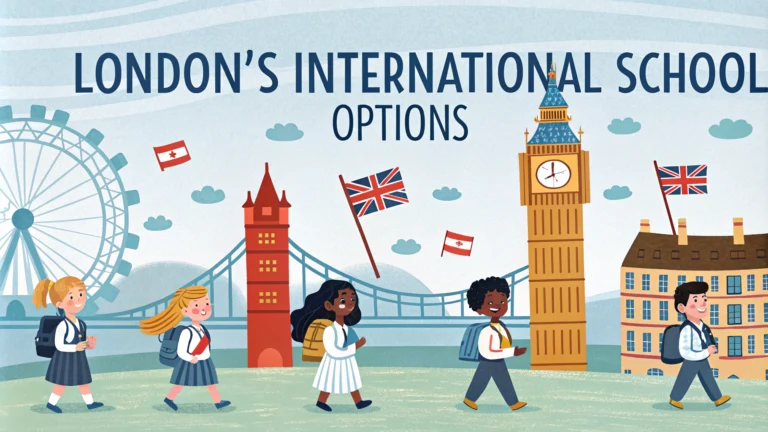London offers numerous international school options for families relocating to or from the city, with over 50 international schools following various curricula from around the world.
Finding the right international school requires careful consideration of factors like location, curriculum, fees, and admission requirements.
This guide explores the main international schools in London, their unique features, and practical tips for selecting the best fit for your children.
Types of International Schools in London
- American Schools (following US curriculum)
- British International Schools (following British curriculum)
- European Schools (following various European curricula)
- IB World Schools (offering International Baccalaureate)
- Bilingual Schools (teaching in multiple languages)
Top American Schools in London
- American School in London (ASL)
Location: St John’s Wood
Ages: 4-18
Curriculum: American
Contact: +44 20 7449 1200 - TASIS The American School in England
Location: Surrey (Greater London)
Ages: 3-18
Curriculum: American with IB option
Contact: +44 1932 565252
Notable British International Schools
- Southbank International School
Multiple London locations
Ages: 3-18
Curriculum: IB
Contact: +44 20 7243 3803 - International School of London
Location: Chiswick
Ages: 3-18
Curriculum: IB
Contact: +44 20 8992 5823
Application Process and Timeline
Most international schools in London accept applications year-round, but it’s recommended to apply at least 6-12 months before the intended start date.
Required Documents
- Previous school records
- Academic transcripts
- Teacher recommendations
- English language proficiency test results (if applicable)
- Passport copy
- Immunization records
Fee Structure
| School Level | Average Annual Fees (£) |
|---|---|
| Primary | 15,000 – 25,000 |
| Secondary | 20,000 – 35,000 |
| Sixth Form | 25,000 – 40,000 |
School Selection Tips
- Consider your child’s previous educational background
- Evaluate the commute time from your intended residence
- Research the curriculum alignment with your future plans
- Visit multiple schools during regular school days
- Speak with current parents and students if possible
- Review extracurricular activities and facilities
Moving Forward With Your Choice
Start your school search by creating a shortlist based on location, curriculum, and budget constraints.
Schedule visits to your top choices and prepare questions about their teaching methods, support services, and community atmosphere.
Submit applications to multiple schools to increase your chances of securing a place, as many international schools have waiting lists.
Finding Support and Resources
- Contact the Council of International Schools: www.cois.org
- Join expatriate parent groups on social media
- Consult with relocation specialists
- Connect with your embassy’s education department
Additional Support Services
- English as an Additional Language (EAL) support
- Special Educational Needs (SEN) provisions
- University counseling services
- Cultural integration programs
- Parent support networks
Transportation Options
Most international schools offer:
- Private bus services covering major London areas
- Designated pick-up and drop-off points
- Transportation coordinators for route planning
- Additional fees for bus services ranging from £2,000-£3,500 annually
Academic Calendar and Schedule
- Term dates typically align with British or American academic calendars
- Three terms per academic year
- School day usually runs from 8:30 AM to 3:30 PM
- After-school activities until 5:00 PM
Making Your International School Journey Successful
Success in international education requires careful planning and ongoing communication between parents, students, and school staff.
Regular assessment of your child’s progress and wellbeing helps ensure they’re adapting well to their new educational environment.
Remember that international schools offer unique opportunities for global perspectives and multicultural experiences that will benefit your child’s future academic and personal development.
FAQs
- What are the main types of international schools available in London?
American, British International, French Lycée, German School, Japanese School, International Baccalaureate (IB) schools, and other European curriculum schools. - How much do international schools in London typically cost?
Annual fees range from £15,000 to £35,000, with additional costs for registration, uniforms, extra-curricular activities, and transportation. - When should I start the application process for London international schools?
Most schools require applications 12-18 months before the intended start date, with some prestigious schools having waiting lists of 2-3 years. - What documents are required for international school applications?
Previous school reports, passport copies, immunization records, academic references, English language proficiency tests (if applicable), and proof of address in London. - Are there any international schools that offer financial aid or scholarships?
Yes, some schools offer merit-based scholarships, sibling discounts, and bursaries, though these are limited and highly competitive. - What curriculum options are available in London’s international schools?
IB programs, American curriculum, British curriculum (GCSE/A-Levels), French Baccalauréat, German Abitur, and various national curricula. - How do international schools handle transitions between different education systems?
Schools typically offer transition programs, ESL support, academic bridging courses, and individual assessment plans to help students adjust. - What are the most popular areas in London for international schools?
North London (St. John’s Wood, Hampstead), West London (Richmond, Kensington), and Central London areas have the highest concentration of international schools. - Do international schools provide transportation services?
Most international schools offer bus services with designated pickup points throughout London, though this usually incurs an additional fee. - What extracurricular activities are typically offered at London international schools?
Sports, music, drama, debate clubs, Model United Nations, language clubs, and various cultural activities reflecting the school’s international character.








